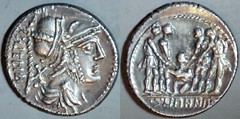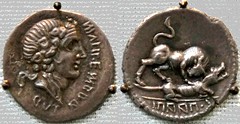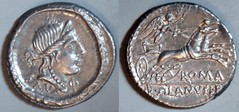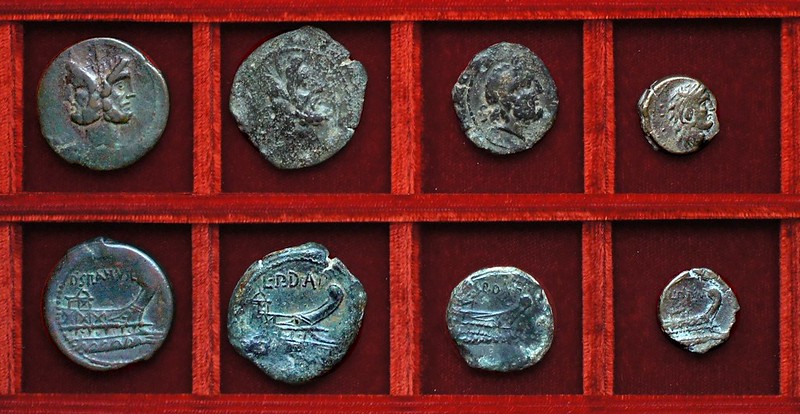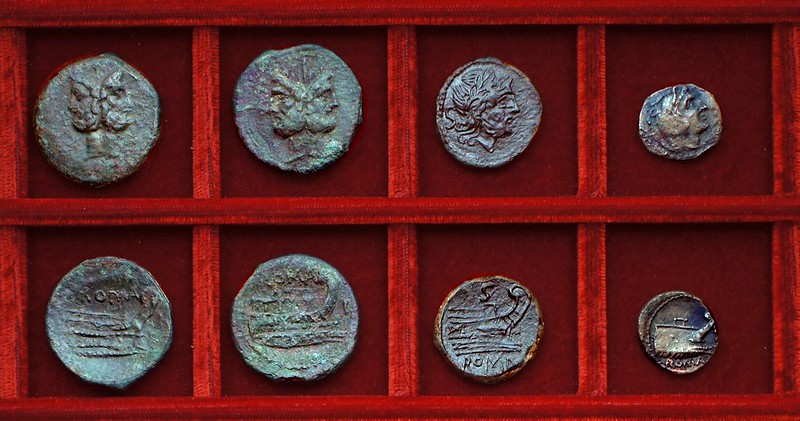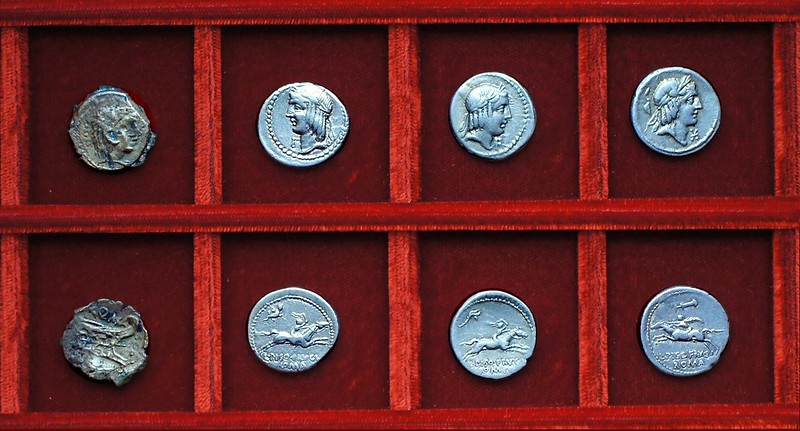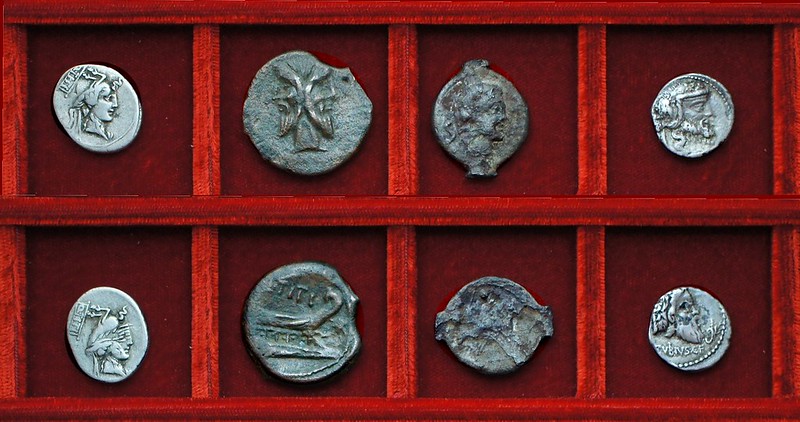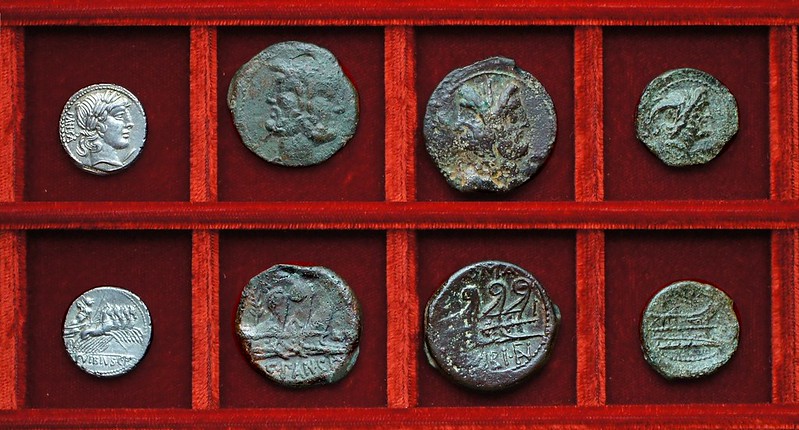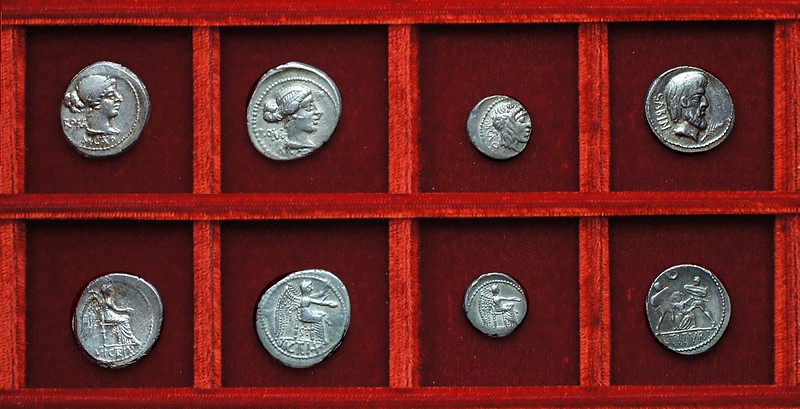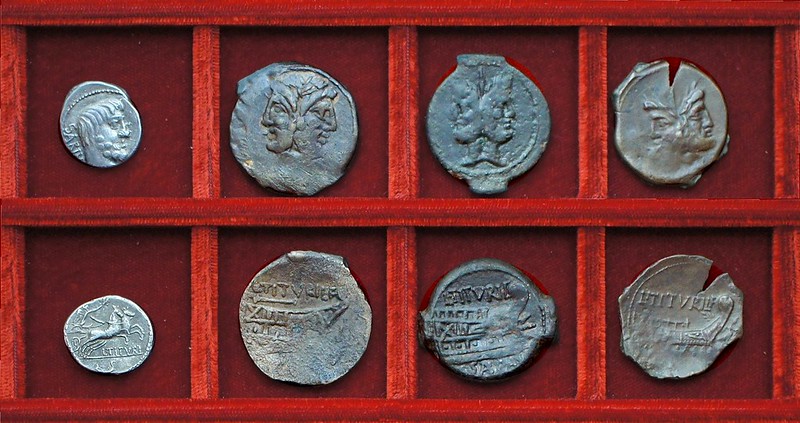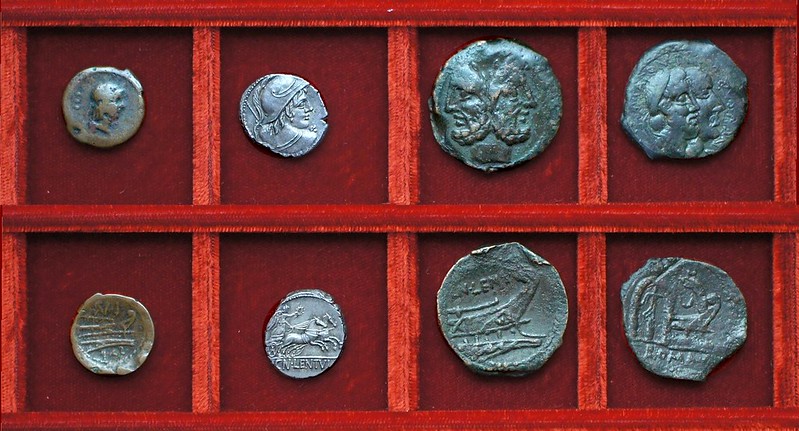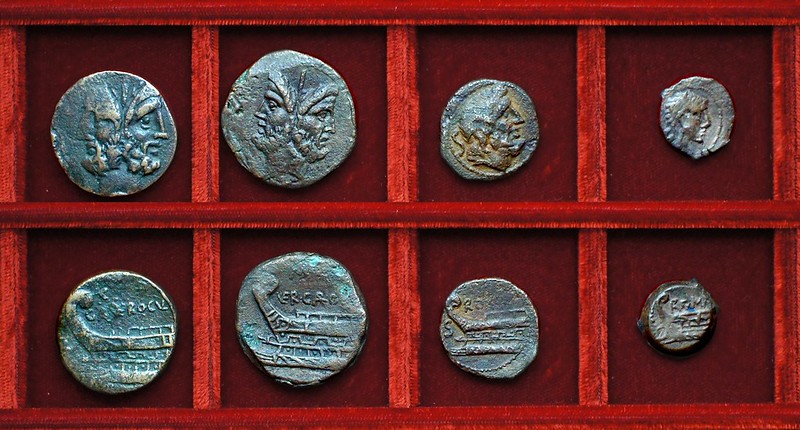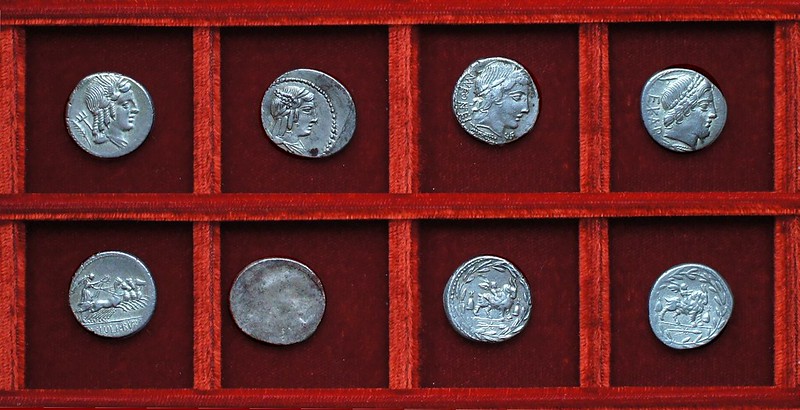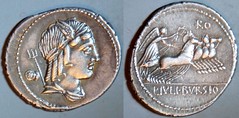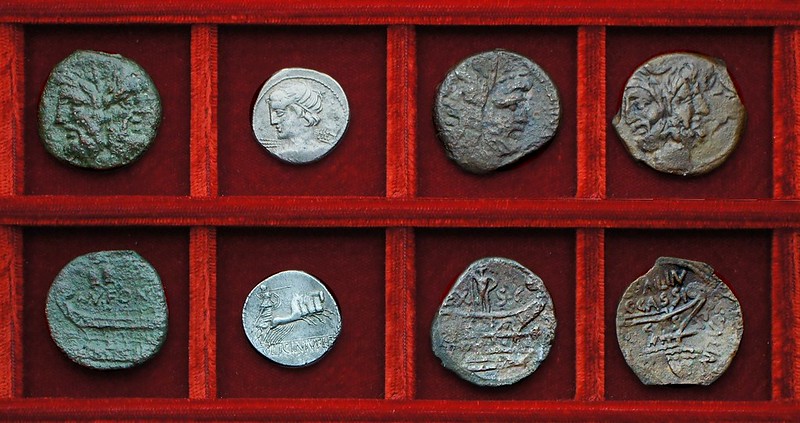Part 12 RRC 336 to RRC 358, 92BC to 83BC, Social War, Sulla, Marius and Cinna
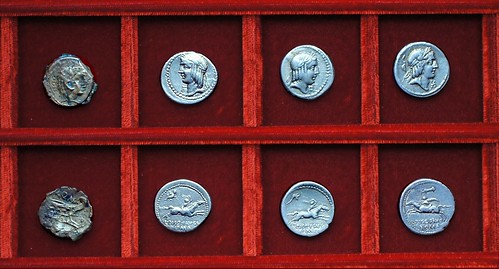
|
Specialist Supplements:
1. Roman Coins of Luceria and Canusium
2. Anonymous Struck Bronze Coins of the Roman Republic
3. Anonymous Roman Republican Denarii and Victoriati (Steve Brinkman's site)
Principal Coins of the Roman Republic
Part 12 RRC 336 to RRC 358, 92BC to 83BC, Social War, Sulla, Marius and Cinna
HNI 415 Social War Italia oath scene denarius, HNI 407 Social War Italia warrior reclining bull denarius. The oath scene types come in several variants and stem from two Roman Republican designs; RRC 28 gold Janus oath scene staters and RRC 234 Veturia Mars oath scene denarius. The form of the figure holding the small pig in the centre and of the warriors pointing their swords is certainly taken from the Roman coins. The social war coins of 91 BC to 88 BC evidently refer to the oaths between the Marsic confederation: Marsi, Peligni, Piceni, Vestini, Samnites, Frentani, Marrucini, and Lucani. It remains a mystery why the Italic allies would refer to the Roman oath scenes and it remains uncertain which oaths the Roman coins commemorated. Crawford (p.715) suggests either the treaty between Titus Tatius and Romulus (Virgil Aeneid xii,639) or between Rome and Alba Longa (Livy i,24) for the scene on RRC 28, and the Numantine treaty of 137 BC for RRC 234, which type may hark back to Samnite treaty of 321 BC following the Caudine forks disaster, given some similarities in circumstances. History may have been rewritten to reflect different glosses on very old treaties as there is no easily understood reason for RRC 234 to commemorate a treaty later regarded as shameful, or for the Marsic confederation to copy types used by the Romans in commemoration of successful treaties against them.
HNI 425 Social War Mars oath scene denarius, HNI 427 Social War Bacchus bull goring wolf denarius. The Italian bull goring the Roman wolf is easier to interpret than the oath scene coins, as is the above type of warrior standing by a recumbant bull. The Social War coinage used Oscan scripts, with Italia rendered as VITELIU in Oscan. Michael Crawford's recent book, Imagines Italicae, publishes the known inscriptions on stone, coinage, pottery and metal of the Italic languages such as Oscan, from peoples who left almost no other text records. Likely after the Social War these languages died out in any official use or as inscriptions.
RRC 236 C.ALLI BALA Allia denarius, RRC 337 D.SILANVS Junia denarii. Vast quantities of Roman coinage were produced during the Social war, in both silver and bronze.
RRC 337 D.SILANVS Junia denarius. Davis coll. The manufacturing quality of the coinage was maintained throughout the war, although there was some reduction in metal quality near the end of the war with the issues of L.Rubrius Dossenus in 87BC struck to about 92% silver as against the usual 99% or effectively pure silver.
RRC 337 D.SILANVS Junia As RRC 338 LPDAP Lege Papiria de Assis Pondere bronzes. The coins with LPDAP certainly refer to the reduction to a semuncial standard (1/24 of a Roman pound or 13.5 grams) of the bronze coinage in 91 BC legislated through the Lex Papiria (Pliny HN 33,46), The reverse letters L.P.D.A.P. stand for lege Papiria de assis pondere (RRC p.611). The weight reduction was likely precautionary (RRC p.596), i.e. not really economically necessary. The moderate quantities of bronzes produced in the period were completely inconsequential in monetary terms, when compared with the vast quantities of silver produced. Examination of Richard Schaefer's Republican Die Project suggest that each of the semuncial As types was struck from, at most, one or two dozen dies per issue, and the semuncial fractions are rare. Compare that to the estimated 864 dies for the denarii of L.Piso Frugi (RRC p.340). The value of Social War silver was evidently vastly greater than that of bronze. The semuncial coins are not present in hoards of the Augustan period, and although the strike quality was very erratically, the above LPDAP As being typical, they are often found in relatively unworn condition, suggesting they dropped quickly from circulation.
RRC 339 semuncial bronzes of various styles. A preliminary analysis of the anonymous semuncial bronzes is given in Andrew McCabe's The Anonymous Struck Bronze Coinage of the Roman Republic: a Provisional Arrangement (2012), within McCabe group M1. The above Asses are characteristic of the official coinage of the period. The Semis is likely imitative. The quadrans is of an official style consistent with RRC 334 L.POMP MOLO but of a semuncial size and weight standard.
RRC 339 semuncial quadrans, RRC 340 L.PISO FRVGI Calpurnia denarii. The anonymous quadrans is a very rare coin that is fully consistent in style with the Asses of RRC 339 and with various coins of RRC 338 LPDAP, and thus proves it as an official issue. Most fractions of semuncial weight can be assumed to be imitations, as they have no stylistic relation to the signed bronzes of the period.
The head left L.Piso Frugi denarius is an extremely rare type. Roberto Russo in NAC 54 wrote: (referring to NAC 54 lot 200) "This L. Piso denarius, unknown to Babelon and Sear, is not a simple variant of the classical type but rather a distinct type in its own right. Infact, classical L. Piso denarii represent the head of Apollo facing left, whilst this type presents the bust in paludamentum in high style and bears a vague resemblance to issues of L. Piso with horse prancing left, hence the reason why we believe them to be the first struck of this magistrate’s copious issue. There are two known varieties of the reverses published by Barfeldt NZ 1896, pl. III, 61 with horseman and whip and pl. III, 62 with horseman and palm leaf. Of the horseman and whip variety we are familiar with the following specimens: 1) Haeberlin 1308, ex. Coll. FONTANA, Paris 1860 n. 84; 2) Haeberlin 1309 sold by HAMBURGER; 3) FFC 344, which may be the same as the NAC54,200 specimen offered here; 4) Private collection [AM: the Ahala collection coin illustrated in the above red tray, ex RBW NAC63]. All from the same pair of dies. [AM: to this list of four coins, Richard Schaefer advises of the existence of 5) Geneva Musée d'Art et d'Histoire; 6) Cambridge 613-2004; 7) Benz Lanz88 214.]
Of the palm leaf type three symbols are known to exist: Palm leaf with Stirrup: 1) Paris 6254; 2) Paris 6255; 3) Turin; 4) Bignami ; 5) Gotha; 6) Vidal Quadras y Ramon; 7) Private collection. It is possible that specimens 4, 5 and 6 ended up either in Paris or Turin. Palm leaf with Arrow: 1) FFC 342; 2) Vienna. Palm leaf with Anchor: Turin.
In conclusion, we know of no more than [seven] specimens of the fantastic whip variety and all are from the same pair of dies whereas of the palm leaf variety, taking into account the three symbols, between six and nine are known to exist. This is undoubtedly one of the greatest rarities of the Republican series. This coin cannot be found at either the British Museum or the American Numismatic Society and has never been offered at a private auction since the sale of Haeberlin in 1933 [AM also Benz Lanz88 214]. As for the stirrup, out of respect for learned scholars, we have [conventionally] interpreted thus this symbol, but we would like to humbly point out that this accessory to smoother riding was introduced in Europe only in the 8th Century AD." (Roberto Russo, in NAC54)
RRC 340 L.PISO FRVGI Calpurnia quinarius, bronzes. The quadrans with Apollo's head matches its obverse type with the denarius of the series. Non-standard bronze reverses occur from time to time in the period from 110 BC to 95BC, but a non-standard obverse coupled with a prow reverse is unusual and rare.
RRC 341 Q.TITI Titia bronzes, denarius flipover strike. RRC 342 C.VIBIVS CF PANSA Vibia denarius. The Titia denarius is an extraordinary example of a flip-over overstrike that retains clear impressions of both the first and second strikes on both sides. In the above view, Bacchus has horses hooves as a head-dress on both obverse and reverse; rotate the coin and it appears as Pegasus on both sides with Bacchus upside down head in place of Pegasus' head. Janus on the As of Titia unusually has a long pointed bears. The related Semis, in poor condition, has a type more usually associated with a denarius: Apollo, with Minerva in a quadriga. The Vibia type with Silenus and Pan heads is a pseudo-double-obverse type: at first glance the obverse and reverse appear similar. Attributes such as Pan's Spock-like pointed ears and small goats horns, and the vines and grapes in Silenus' hair distinguishes them.
RRC 342 C.VIBIVS CF PANSA Vibia denarius, bronzes. There are myriad variations of the legends of C.Vibius Pansa's As, RRC 342/7.
RRC 343 M.CATO Porcia denarii, quinarius. RRC 344 L.TITVRI SABIN Tituria denarius. The letters ST under the chair must related to the seated Victory. Crawford interprets them as Stabilis, referring Livy xxii,37.
RRC 344 L.TITVRI SABIN Tituria denarius, bronzes. The Tituria bronzes also have many variants. The As at right is an unpublished variety ex RBW NAC63, where the palm branch appears both above and below, i.e. behind, the prowstem.
RRC 344 L.TITVRI SABIN Tituria quadrans. RRC 345 CN.LENTVL Cornelia denarius, As. RRC 346 C.CENSORIN Marcia As. Numa Pompilius and Ancus Marcius on the obverse on the RRC 346 As also appears on the denarius types. The complex reverse type with an arch, a Victory column, a prow and crescent still in essence proclaims Rome's naval strength. The quadrans of Tituria borrows the Apollo type from RRC 340.
RRC 346 C.CENSORIN Marcia As. RRC 348 L.RVBRI DOSSEN Rubria denarius, bronzes. Minor variations on the obverse type of the Rubria Asses would hardly have been noticed by the Roman Republic. That at left has a prominent lighted altar between Janus' heads, and the As at right has well-disguised back to back heads of Hercules, at left with club below chin, and Mercury, at right with caduceus below chin, and each wearing their typical lions skin or petasus as appropriate. The variant naval themes appear on RRC 348 as on RRC 346.
RRC 350A GAR VER OGVL Gargilia Vergilia Ogulnia denarii. Four of the five known monogram arrangements are shown above: GAR VER OGVL, GAR OGVL VER, OGLV GAR VER and VER GAR OGVL, with OGVL VER GAR missing. Oddly, the expected sixth variant, VER OGVL GAR, is not known on the denarius but does occur on the As.
RRC 350A GAR VER OGVL Gargilia Vergilia Ogulnia bronzes. RRC 350B prow left bronzes. The GAR VER OGVL bronzes are prolific by the standard of Republican bronzes, but with six combinations, as with the signed RCC 350B denarius, collecting the varieties is troublesome.
RRC 352 L.IVLI BVRSIO Julia denarii. RRC 353 MN.FONTEI Fonteia denarii. The second L.IVLI BVRSIO denarius has a blank reverse: presumably two blanks were struck sandwiched together. Ther are five variants of the Fonteia denarius; the example at right with EX.AP. behind Apollo's head is by far the rarest. EX.AP.
RRC 352 L.IVLI BVRSIO Julia The obverse control mark shows two Roman coins, which appear to be Janus-headed Asses.
RRC 353 MN.FONT Fonteia As. RRC 354 C.LICINIVS MACER Licinia denarius, As. RRC 355 C.CASSIVS SALINVS Cassia As.
RRC 356 P.FOURIVS CRASSIPES Furia denarius. RRC 357 C.NORBANVS Norbana denarii. The Norbana with the gouges on obverse and reverse is an unusual example of a coin with two al-marco gouges. These al-marco gouges appear on a good proportion of early first century BC coins. Clive Stannard showed them to be a weight control measure that operated at batch rather than at coin level. Flans were produced in batches from a slightly excess quantity of silver, so ensuring the silver did not run out before the batch was completed. Therefore the flans were, initially, on average slightly heavier than the weight norm. Then pieces were randomly picked from the batch, a piece gouged out, and the flan returned to the batch, until the batch weighed exactly the correct amount. This would have been a more efficient and faster process, to achieve a batch of exactly the correct weight, than weighing and controlling each coin individually. The coins were struck after the gouging process which took place on blank flans. The nature of the process meant that occasionally a coin might be picked twice, and if not noted as being already gouged, gouged a second time, as happened to the Norbana.
358 LATERENS S.C. Juventia. This type is known from only this specimen. Crawford notes its obverse style, its concave reverse flan and serration to be consistent with Q.Antonius Balbus RRC 364, and suggests 83 BC for its issue, thus preceding the Antonia issue by a year, in the year when Norbana was moneyer, whose father was consul under Cinna. Marcus Juventius Laterensis was Praetor in 51 BC, and our moneyer may have been his father.
With these issues, we leave the period of Marius, Cinna, and the younger Marius, and their wars against Sulla. Having defeated the consul Norbanus, and drawn Carbo and Marius out to battle, Sulla entered Rome in early 83 BC. Whilst RRC 359 was a military camp issue of Sulla, subsequent issues from RRC 360 onwards were minted at Rome under the supremacy of Sulla.
Specialist Supplements:
1. Roman Coins of Luceria and Canusium
2. Anonymous Struck Bronze Coins of the Roman Republic
3. Anonymous Roman Republican Denarii and Victoriati (Steve Brinkman's site)
All content copyright © 2004-2013 Andrew McCabe unless otherwise noted. If you've any questions or comments please contact me on the Yahoo Group RROME: http://groups.yahoo.com/group/RROME.
Alternately you can leave comments against any coin picture, just click on the picture and write in the comment box.
Site hosted free courtesy of VCoins.com
Ancient Coins on Vcoins
comment: this page is RRC336.html







